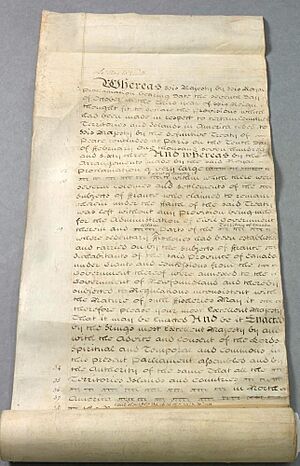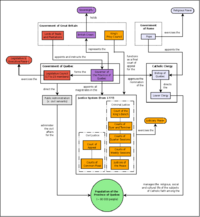Quebec Act facts for kids
| Act of Parliament | |

|
|
| Long title | An Act for making more effectual Provision for the Government of the Province of Quebec in North America. |
|---|---|
| Citation | 14 Geo. 3. c. 83 |
| Territorial extent | Province of Quebec |
| Dates | |
| Royal assent | 22 June 1774 |
| Commencement | 1774 |
| Repealed | 1791 |
| Other legislation | |
| Amended by |
|
| Repealed by | Constitutional Act 1791 |
| Relates to | Coercive Acts |
|
Status: Repealed
|
|
The Quebec Act of 1774 (also known as Acte de Québec de 1774 in French) was an important law passed by the Parliament of Great Britain. This law changed how the Province of Quebec was governed. It made big changes to the province's size and how people lived there.
One of the main parts of the Act was making Quebec much larger. Its new borders included land that is now part of southern Ontario, Illinois, Indiana, Michigan, Ohio, Wisconsin, and parts of Minnesota. This land was previously set aside as an Indian Reserve.
The Act also made important changes about religion and laws. It removed a rule that said public officials had to be Protestant. Instead, it allowed people to freely practice Catholicism. It also brought back the Catholic Church's power to collect tithes (money given to the church). For laws, it brought back French civil law for private matters, like property. But English common law was kept for public matters, like criminal cases.
In Quebec, some English-speaking settlers from the Thirteen Colonies were very unhappy. They felt the Act took away their political freedoms. This Act was one of the reasons that led to the American Revolution. However, many French-speaking Canadiens had different feelings. Landowners, called seigneurs, and church leaders were generally happy with the new rules.
In the Thirteen Colonies, people saw the Quebec Act as a punishment. It was passed around the same time as other laws meant to punish them for events like the Boston Tea Party. These laws were called the Intolerable Acts by the American Patriots. Many colonists also thought the Act would take away their elected assemblies. They were also upset because it gave a lot of land, like the Ohio Country, to Quebec. Americans also saw the Act as favoring Catholicism, which many had fought against in the French and Indian War.
Contents
Why Was the Quebec Act Passed?

After the Kingdom of France lost to the Kingdom of Great Britain in the Seven Years' War, they signed the Treaty of Paris of 1763. In this treaty, France gave New France (which was called Canada by the French) to Britain. France thought its sugar islands like Guadeloupe were more valuable. The British renamed this area along the St. Lawrence River to Quebec, after its capital city, Quebec City.
The British set up rules for their new lands in the Royal Proclamation of 1763. Under the peace treaty, French Canadiens living in Quebec became British subjects. But to work in public offices, they had to swear an oath that rejected the Catholic faith. Since most Canadiens were Catholic, this rule stopped many of them from working in the government.
The British government was worried about growing unrest in the colonies to the south, which was leading to the American Revolution. They feared the Canadiens might join the rebellion. Canadiens made up most of Quebec's population (over 99%). There were not many British immigrants. To keep the Canadiens loyal, governors like James Murray and Guy Carleton pushed for changes. They also needed to find a way to please both the Canadiens and the new British settlers. These efforts led to the Quebec Act of 1774.
What Did the Quebec Act Do?
The Quebec Act made several key changes:
Quebec's New Borders
The Act greatly expanded the size of Quebec. It added land that is now southern Ontario, Illinois, Indiana, Michigan, Ohio, Wisconsin, and parts of Minnesota. This made Quebec three times larger than before. It brought back much of the territory that was part of the French province of Canada.
Religious Freedom
The Act allowed Catholic people to hold public office. It changed the oath officials had to swear. The new oath to George III did not mention rejecting the Protestant faith. This was the first time Canadiens could legally work in the government without giving up their Catholic faith. The Act also brought back the collection of tithes, which had stopped earlier.
How Government Worked
The Act set up the structure of Quebec's government. The King would appoint a governor. This governor would rule with the help of a legislative council. There was no elected assembly, which was different from other British colonies.
Laws and Rights
Before this Act, English common law was supposed to be used for everything in Quebec. The Quebec Act brought back French law for matters like property and civil rights. But English law was still used for public matters, criminal cases, and allowing people to freely decide who gets their property after they die.
Land Use System
The Act brought back the seigneurial system for land. This was the French way of dividing and managing land. The British had tried to use a different system called "townships" in 1763.
Name of the Act
At first, the Act only had a long name: An Act for making more effectual Provision for the Government of the Province of Quebec in North America. People usually called it the Quebec Act, 1774. Later, in 1898, the British Parliament allowed a shorter name: the British North America (Quebec) Act, 1774. However, the Canadian government still calls it the Quebec Act, 1774.
How Did People React to the Quebec Act?
Reaction in Quebec
The British government hoped the Quebec Act would make the Canadiens more loyal. But this didn't quite happen. Governor Guy Carleton wrote in 1775 that while the wealthy Canadiens were happy, the common people (called Habitants) were not. They had gotten used to more freedom and didn't want to be forced into military service. They also worried the Act was just a trick to control them more strictly.
Another official, Chief Justice William Hey, wrote that the Act, meant to please Canadiens, actually made them unhappy. He said they wanted English officers and English laws. The common people were no longer afraid of their old leaders (seigneurs and clergy) and often showed disrespect.
When news of an invasion from the southern colonies arrived, Lieutenant-Governor Cramahé wrote that the Canadiens were unwilling to fight for the province. He noted that while the wealthy, clergy, and middle class were loyal, they could not convince the common people to join them.
Reaction in the Thirteen Colonies
The Quebec Act made the Americans very angry. They called it one of the Intolerable Acts, and it helped lead to the American Revolution.
People living on the frontier, especially from Virginia, were already moving into the Ohio area. Companies like the Ohio Company wanted to buy and sell land there. Americans were upset that the Act seemed to favor Catholicism. They also felt it took away their freedom and traditional rights. The governments of New York, Pennsylvania, and Virginia were especially angry. Their royal charters had given them claims to the Ohio lands, which the Act now gave to Quebec. A protest flag called the George Rex Flag was created in New York because of this.
Newspapers in New England also criticized the Act. They said it gave the King too much power in Canada and limited English law. Editors connected the Quebec Act to other laws that limited American freedoms, like the Tea Act. The First Continental Congress, a meeting of colonial leaders, even wrote to the people of Quebec. They warned them about the "arbitrary" (unfair) and "tyrannical" (cruel) nature of the British Parliament.
The Quebec Act's main effect in the Thirteen Colonies was that it angered the Patriots and disappointed the Loyalists. This helped speed up the conflict that became the American Revolution. The Act is even mentioned in the United States Declaration of Independence as one of the reasons for the rebellion. It says the British were "abolishing the free System of English Laws in a neighbouring Province, establishing therein an Arbitrary government, and enlarging its Boundaries so as to render it at once an example and fit instrument for introducing the same absolute rule into these Colonies."
The First Continental Congress asked Parliament to cancel the Intolerable Acts, but Parliament refused. Instead, in February 1775, Parliament passed the Conciliatory Resolution to try and make the colonists happy. But it was too late, as the war started before the news reached the colonies. The Continental Congress rejected this offer.
In Quebec, the 1774 Act was later replaced by the Constitutional Act 1791. This new Act divided Quebec into two new provinces: Upper Canada and Lower Canada. The Quebec Act of 1774 is also seen as an important step towards religious freedom, similar to the First Amendment to the Constitution of the United States.
See Also
- Constitutional history of Canada
- Timeline of Quebec history
- History of Ontario
- History of Canada
- American Revolution




